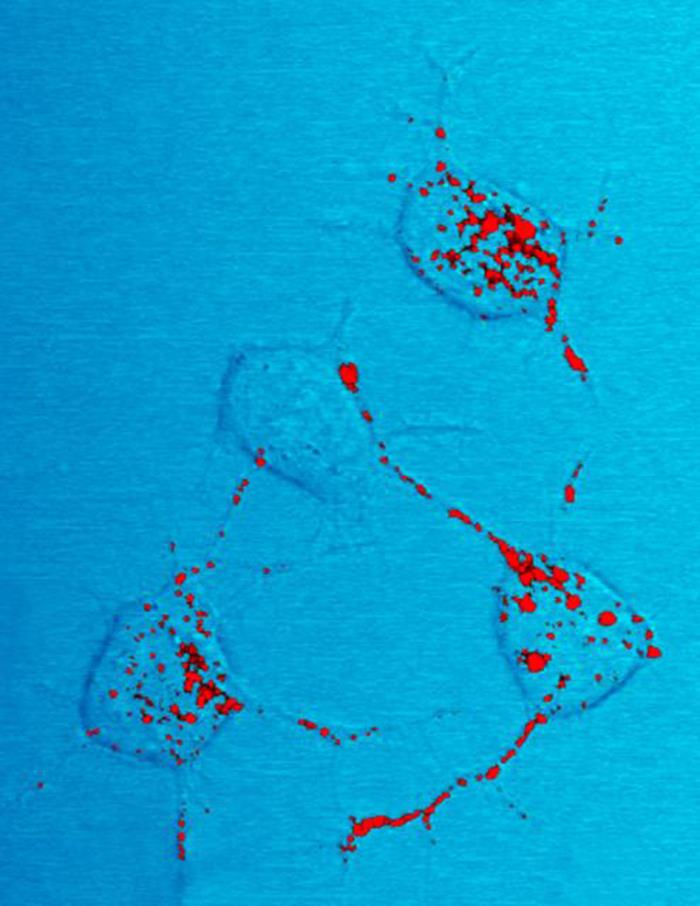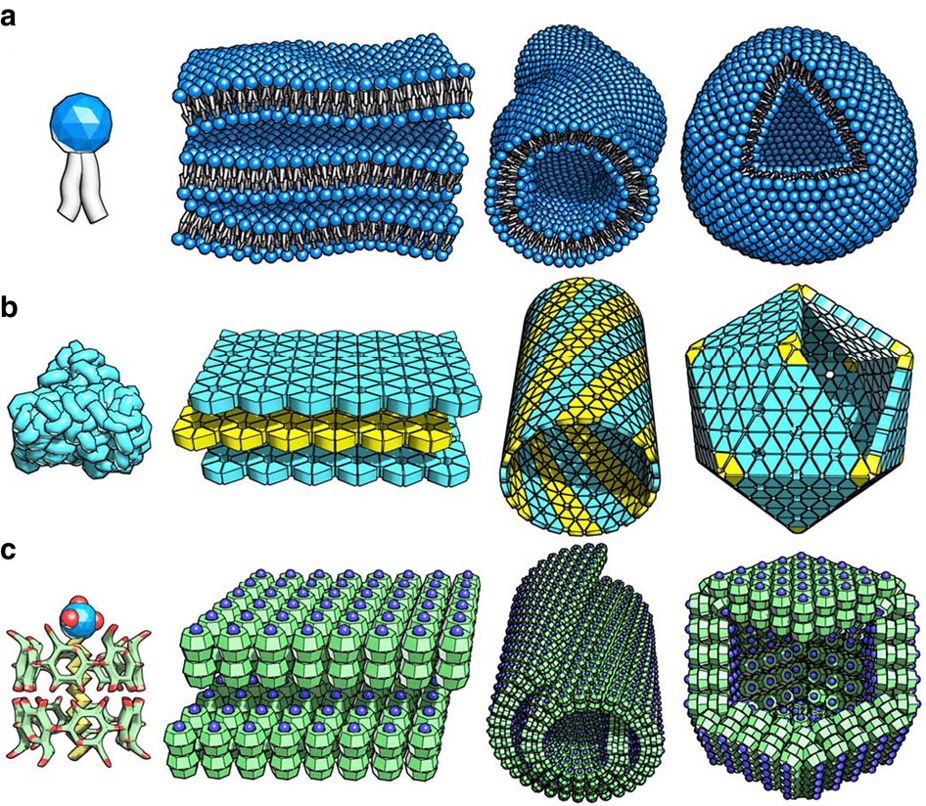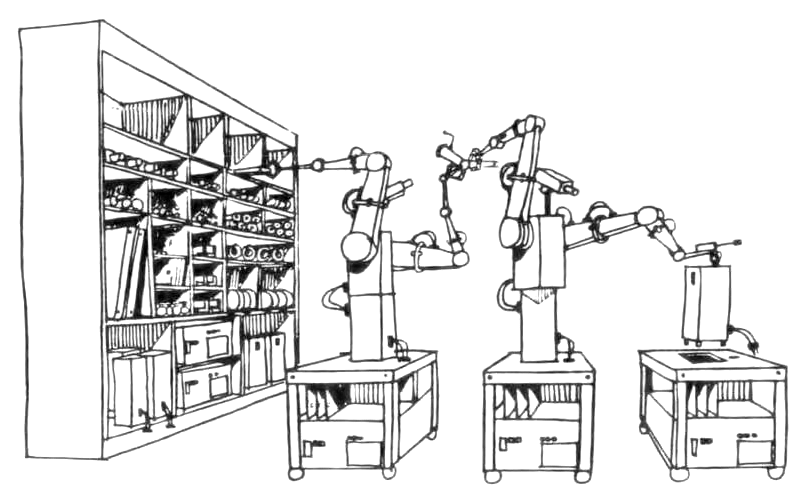|
Self-replication
Self-replication is any behavior of a dynamical system that yields construction of an identical or similar copy of itself. Biological cells, given suitable environments, reproduce by cell division. During cell division, DNA is replicated and can be transmitted to offspring during reproduction. Biological viruses can replicate, but only by commandeering the reproductive machinery of cells through a process of infection. Harmful prion proteins can replicate by converting normal proteins into rogue forms. Computer viruses reproduce using the hardware and software already present on computers. Self-replication in robotics has been an area of research and a subject of interest in science fiction. Any self-replicating mechanism which does not make a perfect copy (mutation) will experience genetic variation and will create variants of itself. These variants will be subject to natural selection, since some will be better at surviving in their current environment than others and will o ... [...More Info...] [...Related Items...] OR: [Wikipedia] [Google] [Baidu] |
Quine (computing)
A quine is a computer program that takes no input and produces a copy of its own source code as its only output. The standard terms for these programs in the computability theory and computer science literature are "self-replicating programs", "self-reproducing programs", and "self-copying programs". A quine is a Fixed point (mathematics), fixed point of an execution environment, when that environment is viewed as a Function (mathematics), function transforming programs into their outputs. Quines are possible in any Turing completeness, Turing-complete programming language, as a direct consequence of Kleene's recursion theorem. For amusement, programmers sometimes attempt to develop the shortest possible quine in any given programming language. Name The name "quine" was coined by Douglas Hofstadter, in his popular 1979 science book ''Gödel, Escher, Bach'', in honor of philosopher Willard Van Orman Quine (1908–2000), who made an extensive study of indirect self-reference, an ... [...More Info...] [...Related Items...] OR: [Wikipedia] [Google] [Baidu] |
Prion
A prion () is a Proteinopathy, misfolded protein that induces misfolding in normal variants of the same protein, leading to cellular death. Prions are responsible for prion diseases, known as transmissible spongiform encephalopathy (TSEs), which are fatal and transmissible neurodegenerative diseases affecting both humans and animals. These proteins can misfold sporadically, due to genetic mutations, or by exposure to an already misfolded protein, leading to an abnormal Protein tertiary structure, three-dimensional structure that can propagate misfolding in other proteins. The term ''prion'' comes from "proteinaceous infectious particle". Unlike other infectious agents such as viruses, bacteria, and fungi, prions do not contain nucleic acids (DNA or RNA). Prions are mainly twisted Protein isoform, isoforms of the major prion protein (PrP), a naturally occurring protein with an uncertain function. They are the hypothesized cause of various transmissible spongiform encephalopath ... [...More Info...] [...Related Items...] OR: [Wikipedia] [Google] [Baidu] |
Cell (biology)
The cell is the basic structural and functional unit of all life, forms of life. Every cell consists of cytoplasm enclosed within a Cell membrane, membrane; many cells contain organelles, each with a specific function. The term comes from the Latin word meaning 'small room'. Most cells are only visible under a light microscope, microscope. Cells Abiogenesis, emerged on Earth about 4 billion years ago. All cells are capable of Self-replication, replication, protein synthesis, and cell motility, motility. Cells are broadly categorized into two types: eukaryotic cells, which possess a Cell nucleus, nucleus, and prokaryotic, prokaryotic cells, which lack a nucleus but have a nucleoid region. Prokaryotes are single-celled organisms such as bacteria, whereas eukaryotes can be either single-celled, such as amoebae, or multicellular organism, multicellular, such as some algae, plants, animals, and fungi. Eukaryotic cells contain organelles including Mitochondrion, mitochondria, which ... [...More Info...] [...Related Items...] OR: [Wikipedia] [Google] [Baidu] |
Sphinx Tiling
In geometry, the sphinx tiling is a tessellation of the plane using the "sphinx", a pentagonal polyiamond, hexiamond formed by gluing six equilateral triangles together. The resultant shape is named for its reminiscence to the Great Sphinx of Giza, Great Sphinx at Giza. A sphinx can be dissection (geometry), dissected into any square number of copies of itself, some of them mirror images, and repeating this process leads to a aperiodic tiling, non-periodic tiling of the plane. The sphinx is therefore a rep-tile (a self-replication, self-replicating tessellation). It is one of few known Rep-tile#Pentagonal rep-tiles, pentagonal rep-tiles and is the only known pentagonal rep-tile whose sub-copies are equal in size. General tilings An outer boundary ("frame") in the shape of a sphinx can also be tiled in a non-recursive way for all orders. We define the order of a sphinx frame on a triangular lattice by the number of triangles at the "tail" end. An order-2 frame can be tiled by f ... [...More Info...] [...Related Items...] OR: [Wikipedia] [Google] [Baidu] |
DNA Replication
In molecular biology, DNA replication is the biological process of producing two identical replicas of DNA from one original DNA molecule. DNA replication occurs in all life, living organisms, acting as the most essential part of heredity, biological inheritance. This is essential for cell division during growth and repair of damaged tissues, while it also ensures that each of the new cells receives its own copy of the DNA. The cell possesses the distinctive property of division, which makes replication of DNA essential. DNA is made up of a nucleic acid double helix, double helix of two Complementary DNA, complementary DNA strand, strands. DNA is often called double helix. The double helix describes the appearance of a double-stranded DNA which is composed of two linear strands that run opposite to each other and twist together. During replication, these strands are separated. Each strand of the original DNA molecule then serves as a template for the production of its counterpart, ... [...More Info...] [...Related Items...] OR: [Wikipedia] [Google] [Baidu] |
Autotroph
An autotroph is an organism that can convert Abiotic component, abiotic sources of energy into energy stored in organic compounds, which can be used by Heterotroph, other organisms. Autotrophs produce complex organic compounds (such as carbohydrates, fats, and proteins) using carbon from simple substances such as carbon dioxide,Morris, J. et al. (2019). "Biology: How Life Works", 3rd edition, W. H. Freeman. generally Photosynthesis, using energy from light or Chemosynthesis, inorganic chemical reactions. Autotrophs do not need a living source of carbon or energy and are the primary production, producers in a food chain, such as plants on land or algae in water. Autotrophs can Redox, reduce carbon dioxide to make organic compounds for biosynthesis and as stored chemical fuel. Most autotrophs use water as the reducing agent, but some can use other hydrogen compounds such as hydrogen sulfide. The primary production, primary producers can convert the energy in the light (phototrop ... [...More Info...] [...Related Items...] OR: [Wikipedia] [Google] [Baidu] |
Self-assembly
Self-assembly is a process in which a disordered system of pre-existing components forms an organized structure or pattern as a consequence of specific, local interactions among the components themselves, without external direction. When the constitutive components are molecules, the process is termed molecular self-assembly. Self-assembly can be classified as either static or dynamic. In ''static'' self-assembly, the ordered state forms as a system approaches equilibrium, reducing its free energy. However, in ''dynamic'' self-assembly, patterns of pre-existing components organized by specific local interactions are not commonly described as "self-assembled" by scientists in the associated disciplines. These structures are better described as " self-organized", although these terms are often used interchangeably. In chemistry and materials science Self-assembly in the classic sense can be defined as ''the spontaneous and reversible organization of molecular units in ... [...More Info...] [...Related Items...] OR: [Wikipedia] [Google] [Baidu] |
Robert Freitas
Robert A. Freitas Jr. (born 1952) is an American nanotechnologist. Early life and education Freitas was born in Camden, Maine. His father worked in agriculture, and his mother was a homemaker. Freitas married Nancy, his childhood sweetheart, in 1974. In 1974, Freitas earned a bachelor's degree in physics and psychology from Harvey Mudd College. In 1978, he received a Juris Doctor (J.D.) degree from the Santa Clara University School of Law. He has written over 150 technical papers, book chapters, and popular articles on scientific, engineering, and legal topics. Career Freitas interests include nanorobotics, how nanotechnology can extend the life of humans, self-replicating machines, and Cryonics. Freitas introduced the concept of "sentience quotient" in the late 1970s. In 1980, Freitas and William Gilbreath were participants in a NASA study regarding "Advanced Automation for Space Missions," and presented the feasibility of self-replicating machines in space, using advan ... [...More Info...] [...Related Items...] OR: [Wikipedia] [Google] [Baidu] |
Ralph Merkle
Ralph C. Merkle (born February 2, 1952) is an American computer scientist and mathematician. He is one of the inventors of public-key cryptography, the inventor of cryptographic hashing, and more recently a researcher and speaker on cryonics. Merkle is a renowned cryptographer, known for devising Merkle's Puzzles, co-inventing the Merkle–Hellman knapsack cryptosystem, and inventing cryptographic hashing ( Merkle–Damgård construction) and Merkle trees. He has worked as a manager at Elxsi, research scientist at Xerox PARC (Palo Alto Research Center), and a nanotechnology theorist at Zyvex. Merkle has held positions as a Distinguished Professor at Georgia Tech, senior research fellow at IMM, faculty member at Singularity University, and board member at Alcor Life Extension Foundation. He received the IEEE Richard W. Hamming Medal in 2010 and has published works on molecular manipulation and self-replicating machines. Ralph Merkle is a grandnephew of baseball star Fr ... [...More Info...] [...Related Items...] OR: [Wikipedia] [Google] [Baidu] |
Computer Science
Computer science is the study of computation, information, and automation. Computer science spans Theoretical computer science, theoretical disciplines (such as algorithms, theory of computation, and information theory) to Applied science, applied disciplines (including the design and implementation of Computer architecture, hardware and Software engineering, software). Algorithms and data structures are central to computer science. The theory of computation concerns abstract models of computation and general classes of computational problem, problems that can be solved using them. The fields of cryptography and computer security involve studying the means for secure communication and preventing security vulnerabilities. Computer graphics (computer science), Computer graphics and computational geometry address the generation of images. Programming language theory considers different ways to describe computational processes, and database theory concerns the management of re ... [...More Info...] [...Related Items...] OR: [Wikipedia] [Google] [Baidu] |
DNA Chemical Structure
Deoxyribonucleic acid (; DNA) is a polymer composed of two polynucleotide chains that coil around each other to form a Nucleic acid double helix, double helix. The polymer carries genetics, genetic instructions for the development, functioning, growth and reproduction of all known organisms and many viruses. DNA and ribonucleic acid (RNA) are nucleic acids. Alongside proteins, lipids and complex carbohydrates (polysaccharides), nucleic acids are one of the four major types of macromolecules that are essential for all known forms of life. The two DNA strands are known as polynucleotides as they are composed of simpler monomeric units called nucleotides. Each nucleotide is composed of one of four nitrogenous base, nitrogen-containing nucleobases (cytosine [C], guanine [G], adenine [A] or thymine [T]), a monosaccharide, sugar called deoxyribose, and a Organophosphate, phosphate group. The nucleotides are joined to one another in a chain by covalent bonds (known as the Phosphod ... [...More Info...] [...Related Items...] OR: [Wikipedia] [Google] [Baidu] |
Python (programming Language)
Python is a high-level programming language, high-level, general-purpose programming language. Its design philosophy emphasizes code readability with the use of significant indentation. Python is type system#DYNAMIC, dynamically type-checked and garbage collection (computer science), garbage-collected. It supports multiple programming paradigms, including structured programming, structured (particularly procedural programming, procedural), object-oriented and functional programming. It is often described as a "batteries included" language due to its comprehensive standard library. Guido van Rossum began working on Python in the late 1980s as a successor to the ABC (programming language), ABC programming language, and he first released it in 1991 as Python 0.9.0. Python 2.0 was released in 2000. Python 3.0, released in 2008, was a major revision not completely backward-compatible with earlier versions. Python 2.7.18, released in 2020, was the last release of ... [...More Info...] [...Related Items...] OR: [Wikipedia] [Google] [Baidu] |





